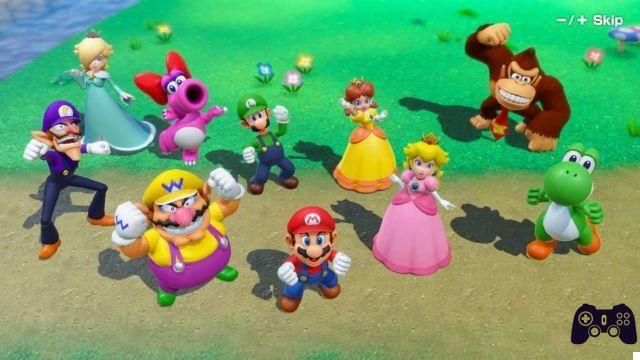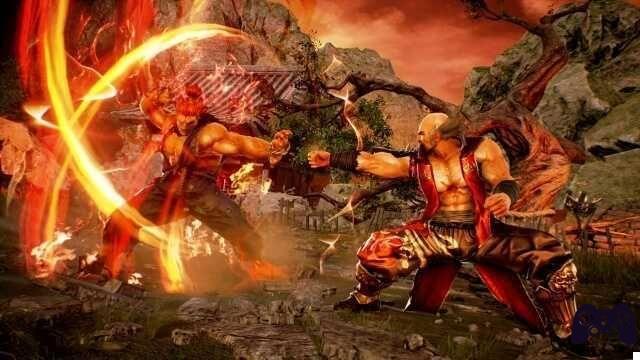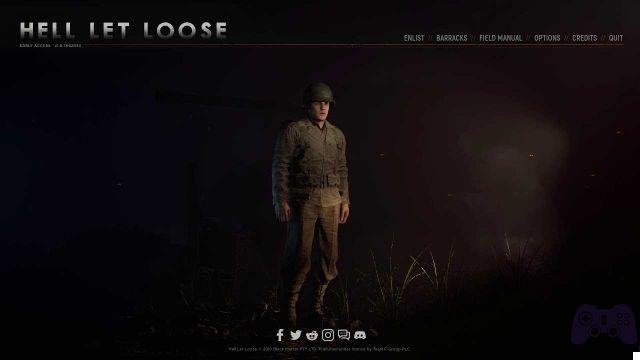Welcome back to the third installment of our in-depth guide to Super Smash Bros. Ultimate's stellar cast of playable characters
In this ours guide, we will devote ourselves to the many characters playable of Super Smash Bros. Ultimate, starting with Mario up to the latest additions of the second Fighters Pass. In each episode we will describe about five or six fighters, however, dividing them according to the chapter of Smash in which they made their debut. As you can see from the image above (taken from a thematic tournament), this time we will talk about the wrestlers who made their debut with Super Smash Bros. Melee for Nintendo GameCube. So let's talk about Peach, of Bowser, The Ice climbers, of Zelda and Sheik. In the appendix we will talk about Scatti e running attacks.
Quick Preamble
Before moving on to the characters, let's clarify the fulcrum of the guide: in Super Smash Bros. Ultimate the task of each player is to throw opponents off the screen, fighting in arenas that mix the genre of fighting with elements of platformer (X and Y allow you to jump). The A and B keys, used in combination with the various directions, give life to the most disparate moves, as well as the back keys to manage shields, dodges and holds. The game also implements tools that irremediably alter the fate of each encounter, but in this guide we will basically focus only and only on the characters themselves. Increasing the opponent's damage will make him lighter and, therefore, vulnerable.
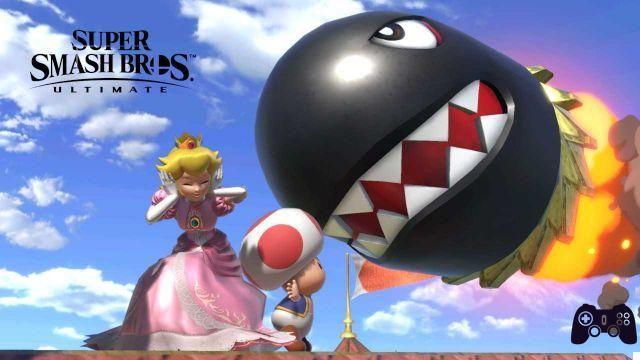
Peach - Super Smash Bros. Ultimate Character Guide
Before Super Princess Peach was released, it was Super Smash Bros. Melee who first showed a version of Peach capable of defending itself. The Princess of the Mushroom Kingdom needs to be saved in every Mario series game, but in this series who will save the rest of the roster from her?
- Franchise of origin: Super Mario
- Origins: Peach made her first appearance in the first Super Mario Bros., but her ability to fly (well, glide) made her debut in Super Mario Bros. 2, itself the western version of the completely unrelated Doki Doki Panic. Peach's arsenal draws heavily on spinoffs, especially sports ones (and Super Mario RPG for the pan), for Smash attacks (right analog lever).
- Gameplay: Peach is full of surprises, despite an average weight. His standard Special Attack (B) is Toad, who here is not a separate character but Peach's real human shield. This translates into the gameplay as a counterattack, or a "tripping" aimed at those who hit us at the exact moment in which we set the trap. We will expand this mechanic in the next installment. Vaulting (↔ + B) is a reliable attack even for beginners, while Vegetable (↓ + B) allows you to extract a turnip from the ground (or, with infinitesimal probability, a Bob-omb) to be thrown later (A). The parasol Peach's (↑ + B) allows you to gain altitude and glide smoothly, and can be used after Peach's second jump which in turn is a glide. Not bad, right?
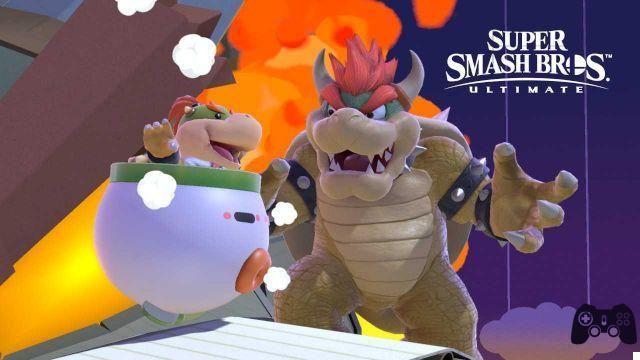
Bowser - Super Smash Bros. Ultimate Character Guide
Where Peach is, there must be as well Bowser: Among the characters that we will discuss in this guide of Super Smash Bros. Ultimate introduced in Melee, the "Koopa king of the demons" brings his immense size in the monumental cast of the game. The relentless kidnapper of princesses is, if we don't consider other fighters like Donkey Kong and the like as ex aequo, the heaviest heavyweight in the game; in addition, contrary to his mobility in Melee and Brawl, from the fourth Smash onwards he became significantly faster.
- Franchise of origin: Super Mario
- Origins: Since Mario's arrival in the Mushroom Kingdom, Bowser's first of Peach's (many) kidnappings has made him indirectly Mario's nemesis. The two have clashed over the span of the most disparate adventures, while not disdaining the occasional alliances in the spinoffs. The relationship with Peach is a lot complex: the context of the kidnappings varies from a mere narrative pretext to the equivalent of a coup d'état in a foreign land, passing through the romantic hypothesis that Super Mario Odyssey has practically confirmed.
- Gameplay: Bowser is a tough nut to crack, but its strengths are not where we would take their presence for granted. The Breath of Fire (B), for example, it is not a bullet, but a medium to short range attack whose range is exhausted as we hold the button down. Backbreaker (↔ + B) is a close range grapple, ending with a deadly suplex if it hits. Acule's vortex (↑ + B) is a third jump that - like Link's spinning attack - can also be used on the ground. Bowser Bomb (↓ + B) is the dive attack used during the final match of Super Mario Bros. 3; when used on the ground, it automatically includes the necessary jump.
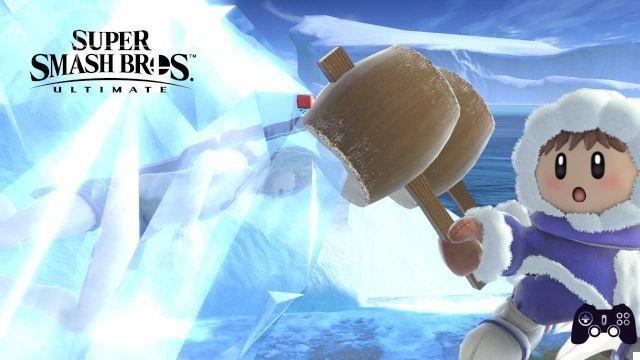
Ice Climbers - Super Smash Bros. Ultimate Character Guide
- Ice climbers ("Ice climber") have given way to a welcome tradition that we will return to often in the course of the guide: that of the "retro characters" which sees an addition from the NES era in every Super Smash Bros .. With them, moreover, we see the introduction of the former experimental mechanics that consecrate the nature of “gameplay of the original game condensed into a single character” of the Masahiro Sakurai series.
- Franchise of origin: Ice Climber
- Origins: The only game of the two climbers, Popo and Nana, is Ice Climber. Born in 1985, this platformer was based on a simple concept: climbing a mountain by one of the two. The gameplay of the game has been revived in Super Smash Bros. Melee with their Icicle Mountain arena, but the scenario is lost in the folds of time when the third episode Brawl replaced it with La Cima. It is not specified what binds the two, whether they are blood relatives, brothers or lovers; the official explanation is that it is up to us to decide. When in doubt, Luigi's speech is valid - Popo is the first player, Nana the second.
- Gameplay: When both Ice Climbers are present, the one who plays the secondary role (Nana in the standard costumes and Popo with the reversed ones) takes no damage and corroborates the attacks of the other, in symbiosis. While it sounds like a huge selling point, actually playing as the duo isn't always plain sailing. If the secondary member is knocked out, the strength of those who remain collapses dramatically. The two can throw forward a piece of ice (B), throw forward with a rotation (↔ + B), throw upwards (↑ + B) and blow cold air (↓ + B), but if the continuous movement on the field there desynchronize (which can also have a strategic advantage) or one of the two fails, things will go wrong. The recovery move, in particular, becomes practically useless if the partner is missing.
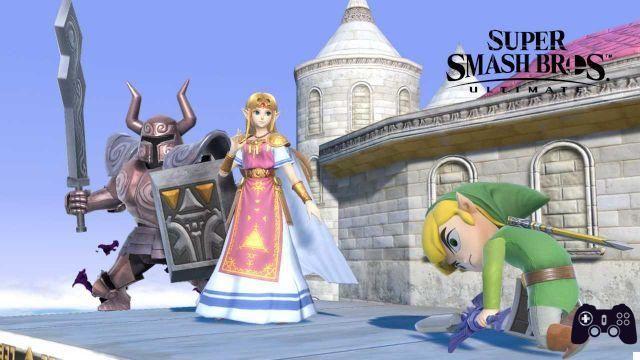
Zelda - Super Smash Bros. Ultimate Character Guide
Two princesses are better than one, so Link has his damsel to save too. Or at least, we would say that if it weren't a situation similar to Peach's… squared. Zelda not only is she perfectly capable of defending herself, but she is also a formidable sorceress.
- Franchise of origin: The Legend of Zelda
- Origins: The same discourse on multiple incarnations applies with Zelda, a series that Super Smash Bros. Ultimate represents for the first time outside of a single episode. Just as the Link of this game is expressly that of Breath of the Wild, the design chosen for this Zelda comes from The Legend of Zelda: A Link Between Worlds for Nintendo 3DS (with more realistic aspect ratio). As a leftover from Melee, however, three out of four special attacks come from The Legend of Zelda: Ocarina of Time.
- Gameplay: Zelda excels in combat long distance, relegating the melee to standard attacks (A). With Love of Nayru (B) It is possible to hold off those who plan to do the same, given the ability of the move to reflect bullets. Din's fire (↔ + B), on the other hand, can hit the farther the longer we hold the button down: great for playing on the surprise effect. Farore's wind (↑ + B) is where things get harder: everything we have already said about Fox and Pikachu also applies in this case, with the addition of a disappearance that makes this directional recovery move even more difficult to govern. From The Legend of Zelda: Spirit Tracks, on the other hand, we have the possibility to summon one Spectrum (↓ + B, image above) which affects only after the assembly of the armor.
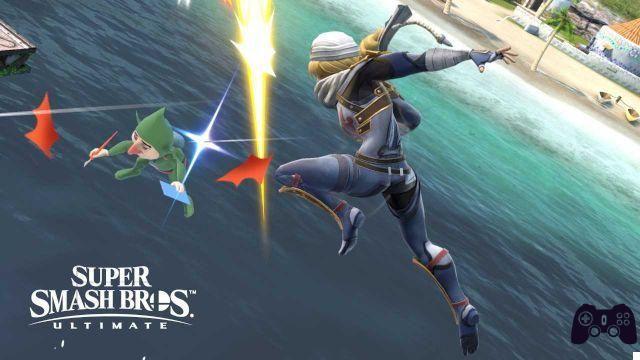
Sheik - Super Smash Bros. Ultimate Character Guide
The (it's complicated) ninja from The Legend of Zelda: Ocarina of Time returns to do damage even among the characters of our guide for Super Smash Bros. Ultimate. In true ninja style, Sheik tip more on speed than on power.
- Franchise of origin: The Legend of Zelda
- Origins: Sheik was born in The Legend of Zelda: Ocarina of Time for Nintendo 64 as a magical transformation (if man) / disguise (if woman) of Zelda to escape from the fearsome Ganondorf. This ally of Link uses the talents of the ancient Sheikah tribe to help the protagonist on his journey. The transition from Melee to Brawl also needed a redesign for Sheik, who could transform into Zelda (and vice versa) at will in the clashes, but unlike the latter, a Twilight Princess design was not available. Luckily for Sakurai, the development team helped him with a discarded draft of the elusive Sheik from Twilight Princess, which is… always Sheik, but with a pigtail.
- Gameplay: Sheik can charge up to six needles (B) following the same principle as Samus. The resulting projectile does not boast an exaggerated throwing power, but as a diversion to undermine the opponent's timing it always proves effective (or landing Tingle, image above). There Blinding Grenade (↔ + B) requires exposure to danger because it is most effective when used closely, throwing a grenade that sucks in opponents before exploding. The Split jump (↓ + B) is a jump with an arc trajectory, which also allows you to hit opponents from above based on timing. There disappearance Sheik's (↑ + B) is similar to that of Zelda, but has a more limited range.
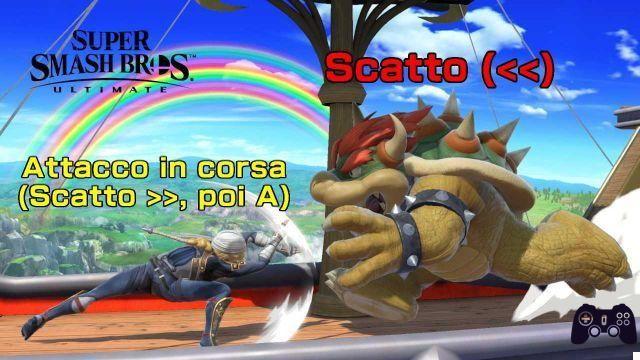
Concluding details, third episode: sprints and attacks on the run
There's no nice way to say it: to play Super Smash Bros. Ultimate, you'll have to go hard with the left analog stick. While a gentle movement of the thumb will move the character gracefully in that direction, a firm snap is needed to make him run. The click it's the only way not to leave the weaknesses of some heavyweights uncovered: we wanted to raise the issue at this very event, as we just talked about Bowser. There are also other slow characters that we will see in the future, from heavy ones like Ganondorf to medium weight ones like Daraen.
If you are able to make the characters gallop properly, you can also have therunning attack. To make one, all you have to do is press A while running. Let's not joke, that's really all. Just be careful not to confuse this with pressing the A key in conjunction with the start of the shot: in this case, in fact, we have the classic input to perform a Smash attack. When playing single Joy-con, it is also the only way to throw them, so be careful. Running attacks range from subtle diversions like Mario's slide to Link's deadly overhead slash. It is up to you to experiment.
And that's all for today: how are you finding yourselves so far? (You can find the summary here.) Please let us know by leaving us a comment below, and don't forget to stay on Holygamerz to not miss any news from the videogame world and beyond.




